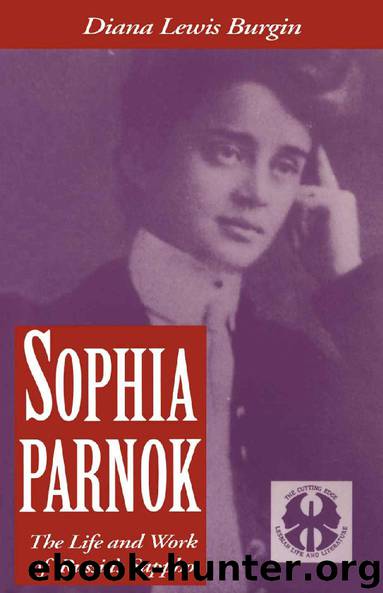Sophia Parnok: The Life and Work of Russia's Sappho (Cutting Edge: Lesbian Life & Literature) by Diana L. Burgin

Author:Diana L. Burgin [Burgin, Diana L.]
Language: eng
Format: epub
Publisher: NYU Press
Published: 1994-06-30T22:00:00+00:00
Weininger’s “prolesbian” stance, unfortunately, depended on his misogynistic view that creativity was essentially a “virile” or masculine province. Indeed, the notion of Sappho’s virile genius seemed to separate her from real-life female poets both in Europe and in Russia. In his 1916 review of Parnok’s Poems, Khodasevich made a point of distinguishing her—ironically, in order to praise her—from those of his female contemporaries whom he considered inferior, “ladies’” poets and “youthful offspring of Sappho.”68
Russian interest in Sappho culminated when the first poetic translations of her “complete” extant poems and fragments appeared. Vyacheslav Ivanov’s flamboyant and decadent “translation,” which augmented many of the fragments beyond recognition, appeared in 1914 and became Parnok’s main (and mediated) source for the Lesbian poet.69 Ivanov had studied with Wilamowitz in Germany. In the introduction to his Sappho and Alcaeus, he revoiced his teacher’s theory that Sappho was the head of a religious community and school for aristocratic young women. He explained Sappho’s strong but chaste “erotic feelings” for her “female pupils” as the central component of her “idiosyncratic, purely Hellenic understanding of her educational task, a task at once moral-religious, artistic, and erotic.”70
The popular writer and amateur Hellenist Vikenty Veresaev published a second poetic, but far more literal, translation of Sappho in 1915. Considering Parnok’s enthusiasm for Sappho, it seems likely that she at least glanced through his translation, but if she did know it, her own Sapphic poems show that she preferred Ivanov’s version.
Veresaev’s view of Sappho drew mainly on the work of Weicker, and exemplified the characteristically Russian denial of the word for Sappho’s love in the name of love for Sappho’s word. Veresaev dismissed the idea that (uppercase) Sapphic love, which he defined as Sappho’s “passionate love for women and lack of erotic feeling for men,” was the same love as the “unnatural perversion” that was called (lowercase) sapphic, or “lesbian” love. He argued that Sappho’s alleged homosexuality was just as scurrilous a “myth” about the great poet as her fatal, unrequited love for Phaon and the “gossip” that “she sold her love to men for money.”71
The Sappho that Parnok discovered in 1914 thus came embedded in cultural accretions, contradictions, sexual ambiguities, and creative pitfalls and potentialities. Added to the Russian attitudes about the original Lesbian poet were the French “sapphistries” of Baudelaire, Verlaine, and Louys, all of whom Parnok had doubtlessly read and absorbed.
Unlike that of other Russian women poets, however, Parnok’s interest in Sappho had a personal dimension that struck to the core of her own creative identity.72 Roses of Pieria represented her first attempts to write her experience of female same-sex love into Russian poetry through emulation of and desire for her distant, creative Other (the original Lesbian poet herself). As such, it remains a unique treatment of Sappho in Russian literature and one of a small number of other, western uses of Sappho that affirm the original woman poet as a great poet and an active (sexual) but nondecadent lover of women.
The volume contained twenty poems, written at
Download
This site does not store any files on its server. We only index and link to content provided by other sites. Please contact the content providers to delete copyright contents if any and email us, we'll remove relevant links or contents immediately.
| African | Asian |
| Australian & Oceanian | Canadian |
| Caribbean & Latin American | European |
| Jewish | Middle Eastern |
| Russian | United States |
4 3 2 1: A Novel by Paul Auster(11746)
The handmaid's tale by Margaret Atwood(7410)
Giovanni's Room by James Baldwin(6754)
Asking the Right Questions: A Guide to Critical Thinking by M. Neil Browne & Stuart M. Keeley(5322)
Big Magic: Creative Living Beyond Fear by Elizabeth Gilbert(5307)
Ego Is the Enemy by Ryan Holiday(4895)
On Writing A Memoir of the Craft by Stephen King(4640)
The Body: A Guide for Occupants by Bill Bryson(4542)
Ken Follett - World without end by Ken Follett(4415)
Bluets by Maggie Nelson(4229)
Adulting by Kelly Williams Brown(4200)
Eat That Frog! by Brian Tracy(4105)
Guilty Pleasures by Laurell K Hamilton(4089)
White Noise - A Novel by Don DeLillo(3807)
The Poetry of Pablo Neruda by Pablo Neruda(3784)
Fingerprints of the Gods by Graham Hancock(3710)
Alive: The Story of the Andes Survivors by Piers Paul Read(3706)
The Book of Joy by Dalai Lama(3652)
The Bookshop by Penelope Fitzgerald(3597)
